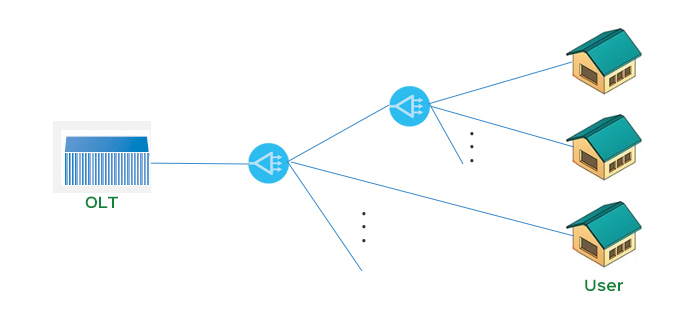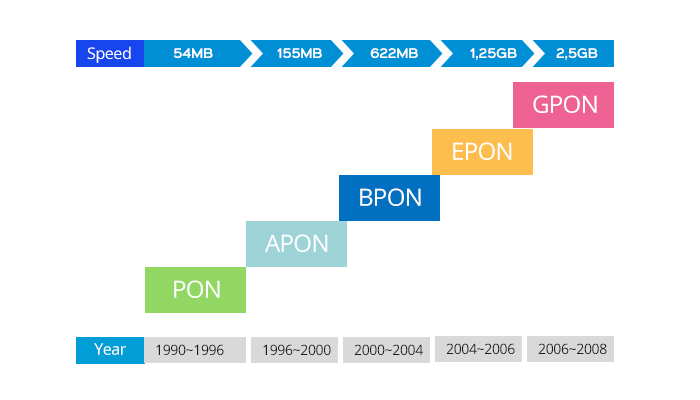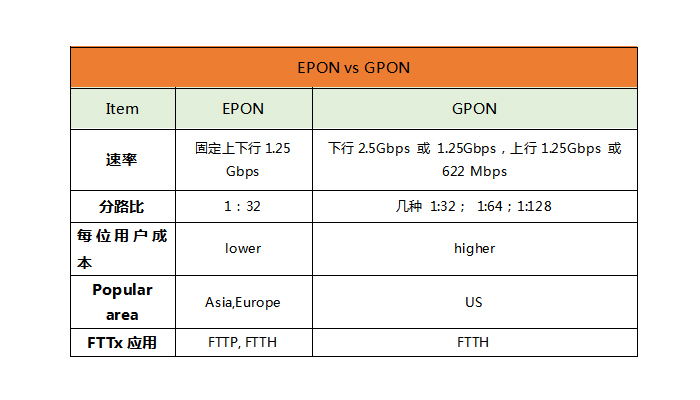Bai-link takes you to a comprehensive understanding of APON, BPON, EPON, GPON
PON (Passive Optical Network) is a passive optical network, which means that the ODN (Optical Distribution Network) between the OLT (Optical Line Terminal) and the ONU (Optical Network Unit) does not have any active equipment and only uses optical fibers and passive components. PON mainly adopts a point-to-multipoint network architecture and is the main technology to realize FTTB/FTTH.
PON technology contains a lot of content and is constantly updated iteratively. The development of xPON technology has gone from APON, BPON, to later GPON and EPON. These are technologies with different transmission modes and transmission standards developed in different periods.

What is APON?
In the late 1990s, the ITU (International Telecommunication Union) first proposed APON that uses Asynchronous Transfer Mode (ATM) for packet communications. APON utilizes centralized and statistical multiplexing of ATM, combined with the shared role of passive splitters in optical fiber and optical line terminals, making the cost 20 - 40% lower than that of traditional circuit-switched-based PDH/SDH access systems.
What is BPON?
With the rapid development of Ethernet technology, APON is basically no longer used. At this time, the concept of Broadband Passive Optical Network (BPON) was proposed. BPON was strengthened after the APON standard. It was originally called APON, but later changed to BPON in order to distinguish it. BPON is based on the ATM protocol, with upstream and downstream speeds of 155 and 622Mbps respectively. It also adds dynamic bandwidth allocation, protection and other functions to provide services such as Ethernet access, video transmission, and high-speed leased lines.
What is EPON?
Due to the high deployment cost of BPON, it was subsequently replaced by EPON, which is more cost-effective and faster. EPON (Ethernet Passive Optical Network) is an Ethernet passive optical network. EPON is based on Ethernet's PON technology, which combines the advantages of PON technology and Ethernet technology. It adopts point-to-multi-point structure and passive optical fiber transmission to provide multiple services on top of Ethernet. Because EPON deployment is economical and efficient, it is the most effective communication method to achieve "triple play" and "last mile".
What is GPON?
GPON (Gigabit-Capable Passive Optical Network) is a gigabit passive optical network or called a gigabit passive optical network. EPON and GPON adopt different standards. It can be said that GPON is more advanced, can transmit larger bandwidth, and can carry more users than EPON. Although GPON has advantages over EPON in terms of high speed and multiple services, GPON's technology is more complex and its cost is higher than EPON. Therefore, at present, EPON and GPON are relatively popular technologies for PON broadband access. Which technology to choose depends more on fiber access costs and business requirements. GPON will be more suitable for customers whose backbone is high bandwidth, multi-service, QoS and security requirements, and ATM technology. The future development is higher bandwidth. For example, the 10G EPON/10G GPON technology has been developed, and the bandwidth will be improved even higher.

As capacity demands on network providers continue to increase, the versatility of access networks must also expand to meet this growing demand. Fiber to the Home (FTTH) passive optical network (PON) optical network access is currently the most widely used and implemented technology. The advantages of PON technology are that it can reduce the resource occupation of backbone optical fibers and save investment; the network structure is flexible and has strong expansion capabilities; passive optical devices have low failure rates and are not easily interfered by the external environment; and strong business support capabilities.
Bailian Bai-link Communications has 20 years of OEM/ODM manufacturing experience in the optical communications industry and has certain influence in the global industry. It focuses on providing customers with one-stop customization in the design, research and development and manufacturing of passive basic optical devices for optical communications. Production, mainly includes PON OLT, ONU, POE series ONU, industrial-grade ONU, GPON/EPON and other product lines. The products are widely used in FTTH, industrial scenarios, 5G networks, monitoring networks, telecommunications networks and other scenarios.












